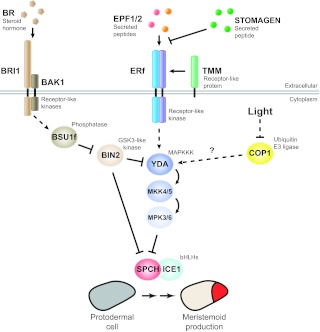Fig. 3.
A mitogen-activated protein kinase (MAPK) pathway transduces and integrates intrinsic and environmental signals during stomatal production. A signal transaction cascade involving the MAPKKK YDA, MKK4/5 and MPK3/6 is employed to repress stomatal production. The EPFL-ERf-TMM module (including the antagonistic STOMAGEN) functioning within the stomatal lineage lies genetically upstream of YDA, activating it through an as yet unknown mechanism. The activated stomatal MAPK module can regulate stomatal development at multiple stages. Shown here is its repression of meristemoid production by MPK3/6 phosphorylation and downregulation of SPCH that is initiated upstream by the EPF2-ERECTA pair. The downstream targets of the MAPK pathway activated by the EPF1-ERL1 pair are not known. An intermediate signaling component in the brassinosteroid (BR) pathway, the GSK3-like kinase BIN2, interfaces with the stomatal development pathway at two levels: by phosphorylating and inhibiting YDA (thus increasing stomata) and by phosphorylating and repressing SPCH (thus decreasing stomata). Light also regulates the number of stomata through the ubiquitin E3 ligase COP1, a central repressor in light signal transduction. Genetic evidence has placed YDA downstream of COP1 but the nature of their molecular link is not known. Arrows indicate positive interactions, T-bars negative interactions. Solid lines indicate confirmed biochemical interactions and dashed lines are indirect or genetic interactions. BAK1, BRI1-ASSOCIATED RECEPTOR KINASE 1; BRI1, BR INSENSITIVE 1; BSU1f, family of BRI1-SUPPRESSOR 1.

